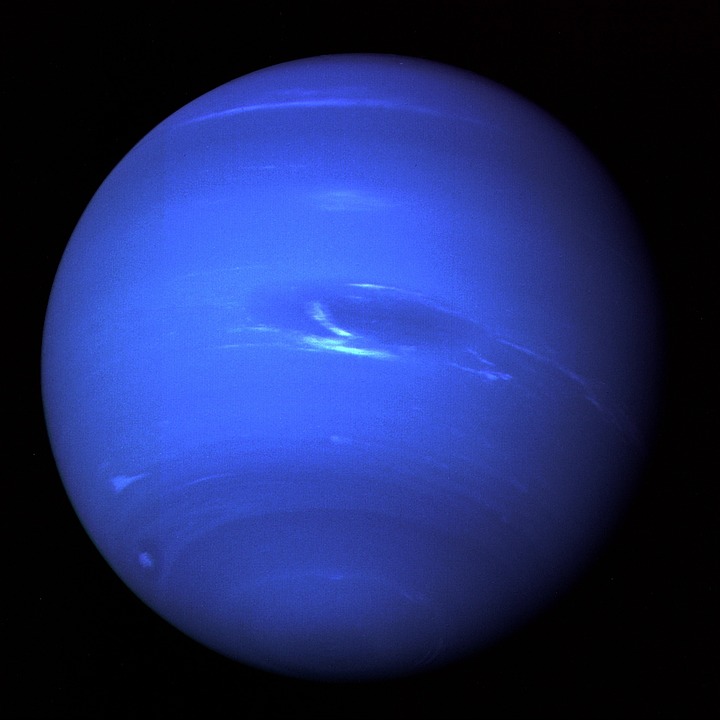Title: Neptune’s Violent Storms and Sustained Winds: A Looking-Glass into Atmospheric Phenomena
Neptune, the farthest planet from the Sun in our solar system, continues to baffle and fascinate astronomers with its enigmatic and extreme atmospheric phenomena. Surrounded by howling winds and raging storms, Neptune presents a valuable opportunity to expand our understanding of the atmospheric processes not just on this distant world, but also on Earth.
In the remote and alien world of Neptune, temperatures plummet to extremely cold conditions, averaging around -214°C (-353°F). Despite these bitterly cold conditions, Neptune’s faint Sun-filtered light paints a bluish color but is magnified by a haze of small, concentrated methane ice crystals—improving our comprehension of how chemical reactions are ignited by sunlight and extreme atmospheric conditions.
One of Neptune’s most noteworthy features is its dynamic atmosphere, defined by massive dark spots and high-speed winds. On Earth, weather systems like cyclones and hurricanes can be destructive and fleeting, but Neptune’s storms are colossal, enduring, and powered by an unimaginable source of energy.
Among Neptune’s storms, the Great Dark Spot is a prominent example. Discovered by Voyager 2 during its flyby in 1989, this gigantic storm is similar to Jupiter’s Great Red Spot in terms of size and function. Spanning about 10,000 kilometers (6,200 miles) across, the Great Dark Spot is so enormous that it could swallow Earth whole. The longevity of such storms remains confounding to researchers. Word from the astronomy camp is that they may last for a few years or even decades, as Neptune’s relatively calm atmospheric conditions don’t rise to topple them easily.
Comparatively, Earth’s storms are fuelled by solar energy and evaporated moisture content, making them more transient. But how do Neptune’s storms persist? Unlike Earth, considered the ‘worshipful Sun’, Neptune has a limited energy source from the distant Sun. Instead, it appears that Neptune channels energy via internal heat, leading to the generation of potent convection currents and thus, a chaotic, violent atmosphere.
Neptune is also characterized by its extreme winds, the sustained speeds of which are exceptional, even amidst the storms. As recorded by Voyager 2, Neptune’s average wind speed at the planet’s equator is roughly 407 miles per hour (655 kilometers per hour). Unlike Mars or Venus, which also showcase intense winds due to their planetary heating dynamics, Neptune’s conditions appear to be a unique setup. The winds pick up speed due to a dramatic temperature difference between the dark cold polar regions and the warmer equatorial areas.
As we have yet to achieve manned space explorations around Neptune, our knowledge relies primarily on data gathered by unmanned explorers like Voyager 2 and the Hubble Space Telescope. However, as technology and our desire to explore the universe continue to improve, scientists anticipate more direct methods of studying Neptune’s gale-force winds and lasting storms.
Image: A captivating Voyager 2 image shows Neptune, with its cloud bands cutting across the blue background of space, and the Great Dark Spot in the lower right corner. (Source: NASA)
FAQs Section
1. Q: What causes the unusual blue hue of Neptune?
A: The blue color of Neptune is attributed to the absorption of red light and the scattered blue light by the methane ice particles in its atmosphere.
2. Q: Are the storms on Neptune harmful to potential manned missions?
A: Though we can currently send unmanned probes to study Neptune due to its harsh conditions, future manned missions would face significant challenges posed by the intense storms and extreme cold temperatures.
3. Q: How are the wind speeds on Neptune measured?
A: Wind speeds on Neptune are estimated using imaging from space probes like Voyager 2 and data on changes in cloud motion across different regions.
4. Q: What is the Great Dark Spot on Neptune?
A: The Great Dark Spot is a colossal, dark storm on Neptune’s surface, similar to Jupiter’s Great Red Spot but larger.
5. Q: Is Neptune the windiest planet in our solar system?
A: According to the currently available data, Neptune is indeed one of the windiest planets. Its average wind speed at the equator is a staggering 407 miles per hour (655 kilometers per hour).
As the boundaries of space exploration continue to expand, our curiosity likewise drives us further into the great unknown. With each probing eye that observes Neptune, our insights surge, pushing past current limitations and enriching our understanding not just of Neptune, but of atmospheric phenomena across the cosmos.



